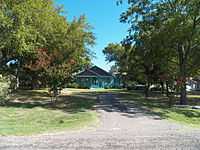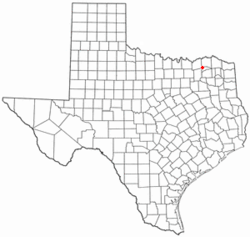Pecan Gap, Texas
| Pecan Gap, Texas | |
|---|---|
| City | |
 | |
| Nickname(s): The Gap | |
 | |
 | |
| Coordinates: 33°26′17″N 95°50′56″W / 33.43806°N 95.84889°WCoordinates: 33°26′17″N 95°50′56″W / 33.43806°N 95.84889°W | |
| Country |
|
| State |
|
| Counties | Delta, Fannin |
| Settled | 1884 |
| Area | |
| • Total | 0.6 sq mi (1.6 km2) |
| • Land | 0.6 sq mi (1.6 km2) |
| • Water | 0.0 sq mi (0.0 km2) |
| Elevation | 571 ft (174 m) |
| Population (2000) | |
| • Total | 203 |
| • Density | 338.3/sq mi (126.9/km2) |
| Time zone | Central (CST) (UTC-6) |
| • Summer (DST) | CDT (UTC-5) |
| ZIP code | 75469[1] |
| Area code(s) | 903 |
| FIPS code | 48-56468[2] |
| GNIS feature ID | 1364973[3] |
| Website | http://www.pecan-gap.com/ |
Pecan Gap is a city in both Delta and Fannin Counties within the U.S. state of Texas. It is sometimes informally referred to as The Gap by the residents of both the town and its immediate surrounding area. The population was 203 at the time of the 2010 census. It is named for the gap between two pecan trees, but unfortunately one of the two pecan trees was destroyed by a tornado in 1963.
History
The first inhabitants of the region which is now the site of Pecan Gap were the Caddo Indians, who settled large portions of eastern Texas as early as 800 A.D. The Caddo were a highly advanced civilization, living in large, wooden structures, and were highly skilled farmers.[4]
Geography
Pecan Gap is located at 33°26′17″N 95°50′56″W / 33.43806°N 95.84889°W (33.438165, -95.848818)[5].
According to the United States Census Bureau, the city has a total area of 0.6 square miles (1.6 km²), all of it land.
Climate
Pecan Gap's climate is considered to be part of the humid subtropical region.
Demographics
As of the census[2] of 2000, there were 214 people, 103 households, and 57 families residing in the city. The population density was 343.6 people per square mile (133.3/km²). There were 123 housing units at an average density of 197.5 per square mile (76.6/km²). The racial makeup of the city was 88.32% White, 7.94% African American, 0.47% Asian, 2.80% from other races, and 0.47% from two or more races. Hispanic or Latino of any race were 6.54% of the population.
There were 103 households out of which 20.4% had children under the age of 18 living with them, 40.8% were married couples living together, 12.6% had a female householder with no husband present, and 43.7% were non-families. 40.8% of all households were made up of individuals and 17.5% had someone living alone who was 65 years of age or older. The average household size was 2.08 and the average family size was 2.78.
In the city the population was spread out with 19.6% under the age of 18, 6.5% from 18 to 24, 31.8% from 25 to 44, 22.9% from 45 to 64, and 19.2% who were 65 years of age or older. The median age was 41 years. For every 100 females there were 98.1 males. For every 100 females age 18 and over, there were 97.7 males.
The median income for a household in the city was $31,389, and the median income for a family was $43,125. Males had a median income of $38,000 versus $22,000 for females. The per capita income for the city was $16,704. About 16.7% of families and 19.0% of the population were below the poverty line, including 18.4% of those under the age of eighteen and 25.0% of those sixty five or over.
Pecan Festival
Held annually on the second Saturday of October, a localized event known as the Pecan Festival (or simply Pecan Fest) takes place. It is organized by the Pecan Gap Ladies Club and features various attractions such as a parade, pet show, lawnmower races, food & drinks, and a gift shop open only during the event.
Education
The City of Pecan Gap is served by the Fannindel Independent School District.
References
- ↑ Staff. "75469 Zip Code Detailed Profile". City-Data.com. Retrieved March 4, 2013.
- ↑ 2.0 2.1 "American FactFinder". United States Census Bureau. Retrieved 2008-01-31.
- ↑ Staff (March 11, 2008). "City of Pecan Gap". Geographic Names Information System (GNIS). United States Geological Survey. Retrieved March 4, 2013.
- ↑ Perttula, Timothy K. "Caddo Indians". Handbook of Texas Online. Texas State Historical Association. Retrieved March 7, 2013.
- ↑ "US Gazetteer files: 2010, 2000, and 1990". United States Census Bureau. 2011-02-12. Retrieved 2011-04-23.
External links
| ||||||||||||||||||||
| ||||||||||||||||||||

